| Common name | Scientific name and subspecies | Range | Size and ecology | IUCN status and estimated population |
|---|
| Pacific gull  | Larus pacificus
Latham, 1801
- L. p. pacificusLatham, 1801
- L. p. georgisKing, 1826
| Australia. | Size:
Habitat:
Diet: | LC
|
|---|
| Belcher's gull or band-tailed gull  | Larus belcheri
Vigors, 1829 | the Pacific coast of South America.
 | Size:
Habitat:
Diet: | LC
|
|---|
| Black-tailed gull  | Larus crassirostris
Vieillot, 1818 | coasts of the East China Sea, Japan, Manchuria and the Kuril Islands, to western Alaska in North America. | Size:
Habitat:
Diet: | LC
|
|---|
| Olrog's gull 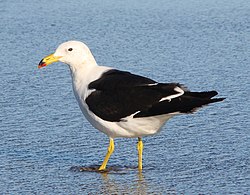 | Larus atlanticus
Olrog, 1958 | Atlantic coast of southern Brazil, Uruguay, and northern Argentina.
 | Size:
Habitat:
Diet: | NT
|
|---|
| Heermann's gull  | Larus heermanni
Cassin, 1852 | Pacific coast of the United States, Mexico and extreme southwestern British Columbia.
 | Size:
Habitat:
Diet: | NT
|
|---|
| Common gull  | Larus canus
Linnaeus, 1758
| northern Palearctic (northern Europe, northern Asia), wintering south to the Mediterranean and China.
 | Size:
Habitat:
Diet: | LC
|
|---|
| Short-billed gull or mew gull  | Larus brachyrhynchus
Richardson, 1831 | northwestern North America.
 | Size:
Habitat:
Diet: | LC
|
|---|
| Ring-billed gull  | Larus delawarensis
Ord, 1815 | Canada and the northern United States, wintering south to the Caribbean.
 | Size:
Habitat:
Diet: | LC
|
|---|
| Yellow-footed gull  | Larus livens
Dwight, 1919 | Gulf of California in Mexico.
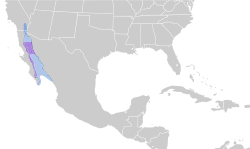 | Size:
Habitat:
Diet: | LC
|
|---|
| Western gull 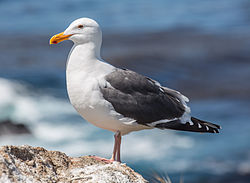 | Larus occidentalis
Audubon, 1839 | from British Columbia, Canada to Baja California, Mexico.
 | Size:
Habitat:
Diet: | LC
|
|---|
| Caspian gull  | Larus cachinnans
Pallas, 1811 | Black and Caspian Seas and adjacent river basins, extending east into Central Asia; wintering west into Europe and south to the coasts of Arabia.
 | Size:
Habitat:
Diet: | LC
|
|---|
| Kelp gull (called southern black-backed gull or karoro in New Zealand)  | Larus dominicanus
Lichtenstein, MHC, 1823
- L. d. dominicanus, Lichtenstein, 1823
- L. d. vetula, (Bruch, 1853)
- L. d. judithae, (Jiguet, 2002)
- L. d. melisandae, (Jiguet, 2002)
- L. d. austrinus, (Fleming, 1924)
| Antarctic Peninsula, southern South America, southern Africa, Southern Ocean Islands, southeastern Australia, and New Zealand.
 | Size:
Habitat:
Diet: | LC
|
|---|
| European herring gull  | Larus argentatus
Pontoppidan, 1763
| northern and northwestern Europe.
 | Size:
Habitat:
Diet: | LC
|
|---|
| Vega gull (or East Siberian gull)  | Larus vegae
Palmén, 1887 | northeastern Siberia, wintering in Japan, Korea, southern and eastern China, and Taiwan. | Size:
Habitat:
Diet: | LC
|
|---|
| Mongolian gull 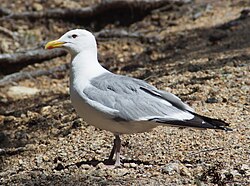 | Larus mongolicus
Sushkin, 1925 | Mongolia and southeastern Russia, wintering in Japan, Korea, southern and eastern China, and Taiwan. | Size:
Habitat:
Diet: | LC
|
|---|
| Yellow-legged gull  | Larus michahellis
Naumann, 1840
- L. m. michahellis Naumann, 1840
- L. m. atlantis(Dwight, 1922), syn. Larus fuscus atlantis, Dwight, 1922
| Mediterranean Sea and Macaronesia, dispersing north as far as the British Isles after breeding.
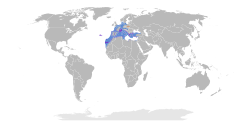 | Size:
Habitat:
Diet: | LC
|
|---|
| Armenian gull  | Larus armenicus
Buturlin, 1934 | interior Turkey, the Caucasus and the Middle East, wintering in the eastern Mediterranean and the Persian Gulf.
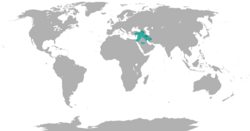 | Size:
Habitat:
Diet: | LC
|
|---|
| Great black-backed gull 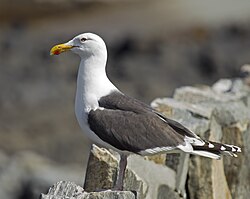 | Larus marinus
Linnaeus, 1758 | northwest European coasts, northeast North American coasts, and islands of the North Atlantic.
 | Size:
Habitat:
Diet: | LC
|
|---|
| Glaucous gull 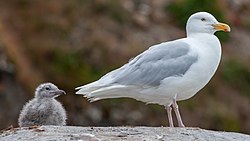 | Larus hyperboreus
Gunnerus, 1767
- L. h. hyperboreus, Gunnerus, 1767
- L. h. pallidissimus, Portenko, 1939
- L. h. barrovianus, Ridgway, 1886
- L. h. leuceretes, Schleep, 1819
| Arctic Ocean coasts, wintering in the North Atlantic and North Pacific as far south as the British Isles and northernmost states of the United States, also on the Great Lakes.
 | Size:
Habitat:
Diet: | LC
|
|---|
| Lesser black-backed gull  | Larus fuscus
Linnaeus, 1758
| Atlantic coasts of Europe and northwest Asia, wintering south to central Africa and India.
 | Size:
Habitat:
Diet: | LC
|
|---|
| California gull  | Larus californicus
Lawrence, 1854
- L. c. californicus Lawrence , 1854
- L. c. albertaensisJehl, 1987
| western interior North America from the Northwest Territories, Canada south to eastern California and Colorado, wintering south to western Mexico.
 | Size:
Habitat:
Diet: | LC
|
|---|
| American herring gull  | Larus smithsonianus
Coues, 1862 | North America from central and southern Alaska to the Great Lakes and northeast coast of the United States from Maine south to North Carolina, wintering south to the Caribbean.
 | Size:
Habitat:
Diet: | LC
|
|---|
| Glaucous-winged gull  | Larus glaucescens
Naumann, 1840 | Pacific Ocean coasts of Russia and Alaska to the coast of Washington, wintering south to Japan and northwest Mexico.
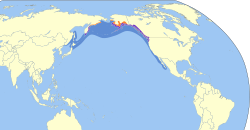 | Size:
Habitat:
Diet: | LC
|
|---|
| Slaty-backed gull  | Larus schistisagus
Stejneger, 1884 | northeastern coasts of Asia, wintering south to eastern China.
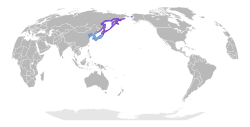 | Size:
Habitat:
Diet: | LC
|
|---|
| Iceland gull  | Larus glaucoides
Meyer, B, 1822
| Arctic Ocean coasts of Canada and Greenland, wintering from Iceland south to the British Isles and the far northeast USA, with subspecies thayeri wintering on the Pacific coast of North America.
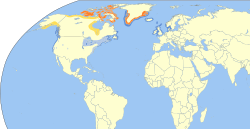 | Size:
Habitat:
Diet: | LC
|
|---|


















































